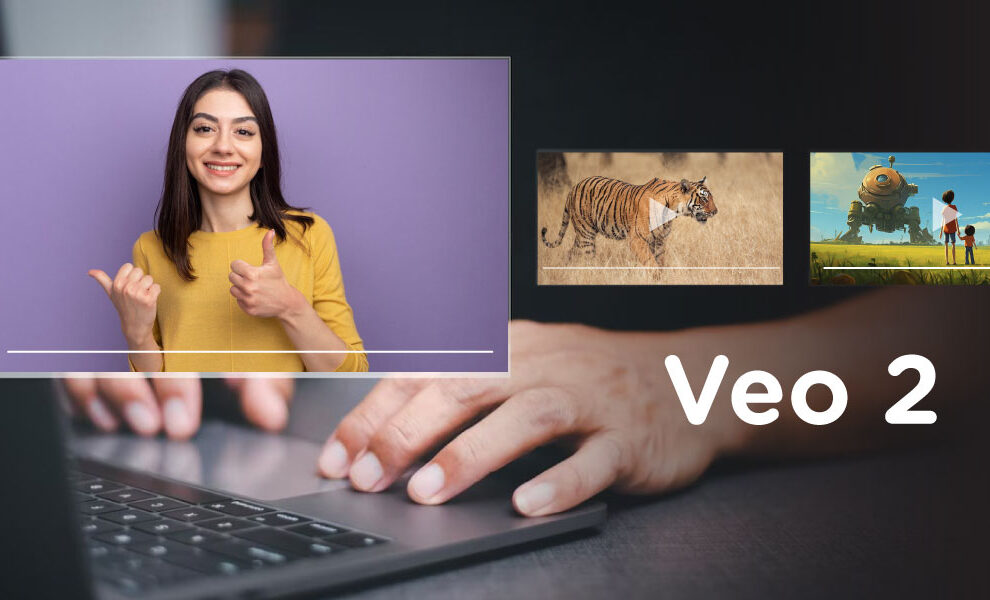Google has introduced a new AI tool called Veo 2 to compete with other big AI companies. Veo 2 can create videos just from simple text instructions. Its design competes with OpenAI’s video generator, Sora. This launch is an important step in the growing competition in the AI field, where companies are constantly trying to expand what AI can do. So, what is Veo 2? How does it work? And how is it different from Sora? Let’s explore in this blog.
What is Veo 2?
Veo 2 is an AI-based video generation tool from Google Research. It allows people to make videos based on a given text. For instance, you could just write down a sentence or some paragraphs about what a scene looks like or what a concept is, and Veo 2 will turn that text into a video with visuals and sounds. It is like other AI-based tools, like making images or generating audio, but Veo 2 focuses on producing whole-length videos.
Veo 2 is a new tool from Google that enhances AI capabilities. It is made for people who want to create high-quality videos but don’t have expensive equipment or professional editing skills. This tool is especially helpful for content creators, educators, marketers, and other users who need video content. With Veo 2, these users can easily make videos without spending too much time and money or needing special expertise.
How does Veo 2 Work?
Veo 2 uses a highly advanced model of machine learning to perceive the context and structure that you input as text. After the AI reads what you are inputting, it constructs a video that is based on the description, taking advantage of pre-existing footage, animations, and special effects. The AI also integrates sound into the video, giving it that complete feel with background noise, voice-overs, and even music.
It works as follows:
You start by typing in a description of what you want the video to show. For instance, you could write, ” A calm beach with soft waves having sunset and people walking on the shore. ”
AI Interpretation: The AI reads the text, identifies the key elements, such as the beach, sunset, waves, and people, and determines the best way to represent those ideas in a video format.
Video Generation: Using its database of images, video clips, and sound assets, the AI then creates a video that matches the description. The result could be a smooth, natural-looking scene with realistic visuals and sounds.
Fine-tuning: Users can make adjustments to improve the video further. This might involve tweaking the color scheme, adding or removing elements, or adjusting the speed of the video.
How is Veo 2 Different from OpenAI’s Sora?
While Veo 2 is a leap of great bounds in video creation, it is certainly not the only AI in the room. OpenAI offers a similar to Sora. It also generates videos based on text input. How then does Veo 2 differ from Sora?
Superior Video Editing Functions
Another aspect of differentiation is that users can control the video they generate at different levels. Google’s Veo 2 is developed with the ability to make video editing much more sophisticated. This enables users to edit their video outputs for very detailed refinement.
For example, users can modify aspects such as lighting, textures, and even scene arrangement. This would mean it is more customized to those people who are aiming to make highly specific videos.
On the other hand, OpenAI’s Sora is more streamlined, aiming to generate videos quickly with minimal input from the user. Sora is built for simplicity and speed, which makes it ideal for users who need to create videos on the fly without worrying too much about the fine details.
Focus on Realism
Another significant difference is how each of the two AIs approaches realism. Veo 2 employs Google’s powerful machine learning models, which are designed to create more realistic and lifelike videos. The AI pays great attention to details such as lighting, motion, and even small background elements. This helps the videos look professional and believable.
In contrast, OpenAI’s Sora may prioritize creativity and novelty over realism, which means it might produce more stylized or abstract videos that are still visually impressive but perhaps not as grounded in reality as Veo 2’s output.
Speed and Efficiency
Sora by OpenAI is quick at generating videos. It is made to be fast, so it can work for rapid projects or when the clock is ticking. Veo 2 by Google is fast and tends to focus more on higher quality. It creates more polished videos that might take a little longer to process, especially if the user is fine-tuning the video or making a complex scene.
Veo 2: Transforming Content Creation with AI
The launch of Veo 2 is part of a larger trend in using AI for creating content in new and exciting ways. Where tools like DALL·E have caused waves by generating images, creating videos is much more complicated and needs resources. Using Veo 2, users can make videos based on a simple text prompt, opening up endless possibilities for marketing and advertising, education, and entertainment.
For businesses, it can assist in the production of marketing videos, ads, and training materials without requiring an entire team of video editors or animators. This may cut costs and save much time, allowing video production to reach more people and companies.
It would make it easier for teachers to create educational videos on even the toughest topics to be understood by the students in a simpler way. For instance, a history teacher can ask an AI to make a video to take a virtual tour through ancient Rome, or a biology teacher can generate animations that show the functioning of a cell.
The Future of Video Creation with Veo 2
With Veo 2, users can expect more accurate and detailed videos, faster processing times, and customization options. The AI industry is advancing quickly, and we are just beginning to explore what tools like Veo 2 can do.
In the future, we might see AI-generated films, documentaries, and even interactive experiences where users can create their own stories with AI’s help. The possibilities are endless, and it is exciting to think about how AI will change how we make and enjoy video content.
Veo 2 is currently only accessible through Google Labs’ VideoFX. New users can join the waitlist on Google Labs to gain access. Google also plans to integrate Veo 2 with YouTube Shorts and other products in 2025, showing its commitment to AI-driven content creation.
Final Words!
With Veo 2, Google is now entering the AI video generation world in a big way, which will compete with OpenAI’s Sora and similar tools. While both of them provide similar functionalities, Veo 2 offers more customization, more advanced editing options, and realism. As AI advances further, we can expect even more breakthroughs in how videos are created, opening up exciting new possibilities for content creators, businesses, and educators alike.
To learn more, visit us at HiTechNectar!
Frequently Asked Questions
Q1. How do I access Google Veo?
Ans. To access Google Veo, you need to sign up for the waitlist on Google Labs. Once you’re on the waitlist, you’ll be notified when you can start using the tool. Keep an eye on your email for updates from Google regarding your access.
Q2. What is Veo 2?
Ans. Veo 2 is an innovative AI tool developed by Google that allows users to create videos from simple text prompts. It simplifies video production, making it accessible to anyone, even without professional skills or expensive equipment. This tool aims to enhance content creation for various users, including marketers and educators.
Q3. Can Veo videos be downloaded?
Ans. Yes, videos created with Veo 2 can be downloaded for personal or professional use. This feature allows users to easily share their videos on different platforms or keep them for future reference. Make sure to check the specific options available when using the tool.
Q4. Is Veo AI free?
Ans. Veo 2 may offer some features for free, but there could also be paid options for advanced tools or capabilities. It’s best to check Google Labs for the latest information on pricing and subscription plans. This way, you can understand what features are available at no cost and what might require payment.
Recommended For You:



